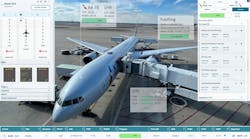How many of you recall the days when we would open a hard copy manual, or page through a parts catalog with dirty finger prints? I do. As time flew by, paper manuals gave way to microfiche, which gave way to PDF manuals on a computer, which gave way to…well we all know the story.
Information Technology (IT) moves at a rapid pace and maintenance data can be accessed in the cloud at any time, from most any location, on most any device.
Aircraft Technical Publishers (ATP) is one company with a long history of leveraging IT to help the industry evolve by transforming the way maintainers access and manage maintenance-related content.
Over the past year and a half, I’ve had the pleasure of getting to know the new CEO Charles Picasso. Charles has extensive experience as an executive who has led global enterprise software, internet services, and business information service providers.
Recently I asked Charles a few questions regarding the maintenance information business.
AMT: Charles, thanks for taking time out of your busy schedule. I’d like to begin by asking if you would give our readers a brief history lesson on ATP. I believe ATP started in the early 1970s as a provider of basic maintenance libraries for the general aviation maintenance shops – correct?
CP: That’s right. ATP was founded to help maintenance providers and owner/operators manage the flood of constantly changing technical, operating and regulatory content. We’ve leveraged that technology to help the industry evolve more efficiently. Today, our unified cloud solution helps seamlessly manage all of their end-to-end maintenance processes from maintenance and compliance tracking, to diagnostics, troubleshooting, and fault detection to inventory management. And because we've cultivated close relationships with our customers — as well as aircraft manufacturers and regulatory agencies worldwide — we’re positioned at the hub of this unique constellation of collaborative partnerships.
AMT: And today, ATP provides complete aircraft maintenance information solutions to virtually all segments of the industry. Can you describe some of them?
CP: Our goal is to help our customers work smarter and faster through IT, whether general, business, or commercial aviation. In recent years, ATP has invested a lot into creating this unified cloud platform to interconnect data, workflows, and processes, which in turn, creates a tremendous amount of industry value in terms of productivity, cost savings, speed, and aircraft utilizations, as well as improved safety and compliance. Our new vision broadens our traditional focus from content management to become a services-oriented company that delivers “smart content” services through an integrated platform.
AMT: ATP has moved into providing maintenance information to the airline and large MRO segments, also correct?
CP: That’s correct. We’re looking to leverage our unique market position as well as our cloud platform, which enables unified process management to create information service solutions that span both general and commercial aviation. In the MRO space, we’re focusing on integrated troubleshooting and fault detection solutions that help them accelerate return to service and boost aircraft availability while cutting AOG risk.
AMT: What do you see as the largest changes over the past say decade regarding maintenance documentation and information?
CP: The industry has seen increasing regulations and requirements to boost safety and efficiency, which of course, drives the need for better information management and compliance tracking. And we’re continuing to see greater complexity in all areas from the variety of aircraft being manufactured to the increasing sophistication and interdependence of the components and systems. The result is maintenance technicians and owner/operators have to juggle all of these interdependent and changing pieces of the puzzle and make them fit together to keep aircraft safe and in compliance. That’s why a cloud solution is ideal for helping them manage all of this in an integrated fashion.
AMT: Are your customers demanding more information services these days and if so what are they asking for?
CP: I think so. Customer expectations are formed from their experiences with service providers in other industries. For example, consumers see how their bank, cell phone, and cable companies have leveraged IT to make their lives easier. Naturally they ask, why can’t our industry be as efficient in delivering the right information to me at the right time whenever I need it? One example is accessibility. People rely on their phones and tablets to read books and conduct business, so we’ve invested a lot to make it easier for them to have anywhere, anytime access. Our new mobile app allows them to get content on any mobile device, including the ability to easily share or store publications on their devices even if they’re on a remote mountain without internet access.
AMT: Since you came on board, I’ve seen a few strategic business moves such as the collaboration with WebManuals in Sweden and the acquisition of Case Bank Technologies in Canada. Let’s begin with WebManuals. How does this relationship work, what synergies are realized, and how does this benefit the industry and your subscribers?
CP: WebManuals specializes in operations manuals and have developed a cloud and web-based application that helps streamline the ability to author, distribute, and update that content. So yes, we have been strategic in looking at other industry players that have complementary solutions and are similar in that they’re also innovators who are looking to leverage IT as a game changer versus simply making incremental improvements. Instead of reinventing the wheel, it makes sense to partner with them so that we can realize synergies by connecting all of this data together since a lot of this information is related and interdependent.
As for CaseBank Technologies, this was an ideal strategic fit in many ways. Troubleshooting and fault detection is a very specialized competency and they’ve developed a tremendous amount of specialized software and expertise to do it better than anyone else. Basically, CaseBank developed a sophisticated hybrid reasoning engine with patented algorithms that accelerates the process of pinpointing problems and guides technicians through the quickest path to resolving them. And since ATP’s core competencies are around managing maintenance-related content and we share the same target audience, we realized early on that we could drive a lot of additional value by integrating these complementary solutions together, which we’re currently in the process of doing today.
AMT: Charles, can you share with our readers your vision of where maintenance information and the direction your company is moving?
CP: We’ve come a long way in a short amount of time, but there’s still a lot of work to do to realize our vision of unified process management. We’re constantly looking past the horizon by imagining new ways of making life easier for aircraft maintenance providers. There are still a lot of opportunities to create value by fully integrating technical documentation into the entire maintenance process, which boosts not only productivity and flight availability, but also the safety efforts of the industry as a whole. As I mentioned earlier, ATP is in a unique position as the hub connecting all of the players. We have deep relationships with manufacturers and are uniquely able to integrate all of this maintenance-related information under one roof — everything from maintenance and parts histories, maintenance forecasting, operations manuals, troubleshooting, and fault detection.
To give you a preview of things to come — we’re currently in the process of streamlining all of this further through customized smart content. In the near future, you’ll be able to input a specific tail number and we’ll provide all of the relevant information for your specific engine, airframe and so on, including all of the related documentation on troubleshooting, compliance, operating manuals and so on. We’re proud and excited to help the industry evolve by interconnecting data, processes, and workflows to help the people on the front lines do their jobs better, faster, and more accurately.




